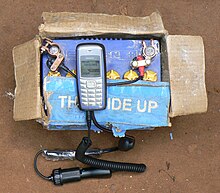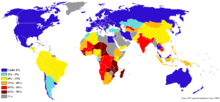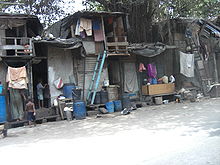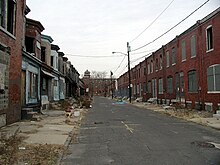Historically, poverty reduction has been largely a result of economic growth. The industrial revolution led to high economic growth and eliminated mass poverty in what is now considered the developed world. In 1820, 75% of humanity lived on less than a dollar a day, while in 2001, only about 20% do. As three quarters of the world's poor live in the country side, the World Bank cites helping small farmers as the heart of the fight against poverty. Economic growth in agriculture is, on average, at least twice as effective in benefiting the poorest half of a country’s population as growth generated in non-agricultural sectors. However, aid is essential in providing better lives for those who are already poor and in sponsoring medical and scientific efforts such as the green revolution and the eradication of smallpox.
Economic liberalization

Ian Vásquez, director of the Cato Institute's Project on Global Economic Liberty, wrote that extending property rights protection to the poor is one of the most important poverty reduction strategies a nation could take. Securing property rights to land, the largest asset for most societies, is vital to their economic freedom. The World Bank concludes increasing land rights is ‘the key to reducing poverty’ citing that land rights greatly increase poor people’s wealth, in some cases doubling it. Peruvian economist Hernando de Soto has estimated that state recognition of the property of the poor would give them assets worth 40 times all the foreign aid since 1945. Although approaches varied, the World Bank said the key issues were security of tenure and ensuring land transactions were low cost.
In China and India, noted reductions in poverty in recent decades have occurred mostly as a result of the abandonment of collective farming in China and the cutting of government red tape in India. However, ending government sponsorship of social programs is sometimes advocated as a free market principle with tragic consequences. For example, the World Bank presses poor nations to eliminate subsidies for fertilizer even while many farmers cannot afford them at market prices. The reconfiguration of public financing in former Soviet states during their transition to a market economy called for reduced spending on health and education, sharply increasing poverty.
Trade liberalization increases the total surplus of trading nations. Remittances sent to poor countries, such as India, are sometimes larger than foreign direct investment and total remittances are more than double aid flows from OECD countries. Foreign investment and export industries helped fuel the economic expansion of fast growing Asian nations. However, trade rules are often unfair as they block access to richer nations’ markets and ban poorer nations from supporting their industries. Processed products from poorer nations, in contrast to raw materials, get vastly higher tariffs at richer nations' ports. A University of Toronto study found the dropping of duty charges on thousands of products from African nations because of the African Growth and Opportunity Act was directly responsible for a "surprisingly large" increase in imports from Africa. However, Chinese textile and clothing exports have encountered criticism from Europe, the United States and some African countries.
Deals can also be negotiated to favor developing countries such as China, where laws compel foreign multinationals to train their future Chinese competitors in strategic industries and render themselves redundant in the long term. In Thailand, the 51 percent rule compels multinational corporations starting operations in Thailand give 51 percent control to a Thai company in a joint venture.
Capital, infrastructure and technology

Investments in human capital, in the form of health, is needed for economic growth. Nations do not necessarily need wealth to gain health. For example, Sri Lanka had a maternal mortality rate of 2% in the 1930s, higher than any nation today. It reduced it to .5-.6% in the 1950s and to .06% today while spending less each year on maternal health because it learned what worked and what did not. Cheap water filters and promoting hand washing are some of the most cost effective health interventions and can cut deaths from diarrhea and pneumonia. Knowledge on the cost effectiveness of healthcare interventions can be elusive but educational measures to disseminate what works are available, such as the disease control priorities project.
Human capital, in the form of education, is an even more important determinant of economic growth than physical capital. Deworming children costs about 50 cents per child per year and reduces non-attendance from anemia, illness and malnutrition and is only a twenty-fifth as expensive to increase school attendance as by constructing schools.
UN economists argue that good infrastructure, such as roads and information networks, helps market reforms to work. China claims it is investing in railways, roads, ports and rural telephones in African countries as part of its formula for economic development. It was the technology of the steam engine that originally began the dramatic decreases in poverty levels. Cell phone technology brings the market to poor or rural sections. With necessary information, remote farmers can produce specific crops to sell to the buyers that brings the best price.
Such technology also makes financial services accessible to the poor. Those in poverty place overwhelming importance on having a safe place to save money, much more so than receiving loans. Also, a large part of microfinance loans are spent on products that would usually be paid by a checking or savings account. Mobile banking addresses the problem of the heavy regulation and costly maintenance of saving accounts. Mobile financial services in the developing world, ahead of the developed world in this respect, could be worth $5 billion by 2012. Safaricom’s M-Pesa launched one of the first systems where a network of agents of mostly shopkeepers, instead of bank branches, would take deposits in cash and translate these onto a virtual account on customers' phones. Cash transfers can be done between phones and issued back in cash with a small commission, making remittances safer
Aid

Aid in its simplest form is a basic income grant, a form of social security periodically providing citizens with money. In pilot projects in Namibia, where such a program pays just $13 a month, people were able to pay tuition fees, raising the proportion of children going to school by 92%, child malnutrition rates fell from 42% to 10% and economic activity grew by 10%.Researchers say it is more efficient to support the families and extended families that care for the vast majority of orphans with simple allocations of cash than supporting orphanages, who get most of the aid.
Some aid, such as Conditional Cash Transfers, can be rewarded based on desirable actions such as enrolling children in school or receiving vaccinations. In Mexico, for example, dropout rates of 16-19 year olds in rural area dropped by 20% and children gained half an inch in height.Initial fears that the program would encourage families to stay at home rather than work to collect benefits have proven to be unfounded. Instead, there is less excuse for neglectful behavior as, for example, children stopped begging on the streets instead of going to school because it could result in suspension from the program.
Another form of aid is microloans, made famous by the Grameen Bank, where small amounts of money are loaned to farmers or villages, mostly women, who can then obtain physical capital to increase their economic rewards. For example, the Thai government's People's Bank, makes loans of $100 to $300 to help farmers buy equipment or seeds, help street vendors acquire an inventory to sell, or help others set up small shops. While advancing the woman and her household's position economically, microloans empower women and enable them to voice their opinions in general household decisions.
Aid from non-governmental organizations may be more effective than governmental aid; this may be because it is better at reaching the poor and better controlled at the grassroots level. Critics argue that some of the foreign aid is stolen by corrupt governments and officials, and that higher aid levels erode the quality of governance. Policy becomes much more oriented toward what will get more aid money than it does towards meeting the needs of the people.Supporters of aid argue that these problems may be solved with better auditing of how the aid is used.[107] Immunization campaigns for children, such as against polio, diphtheria and measles have save millions of lives.
A major proportion of aid from donor nations is tied, mandating that a receiving nation spend on products and expertise originating only from the donor country. For example, Eritrea is forced to spend aid money on foreign goods and services to build a network of railways even though it is cheaper to use local expertise and resources. US law requires food aid be spent on buying food at home, instead of where the hungry live, and, as a result, half of what is spent is used on transport.
One of the proposed ways to help poor countries has been debt relief. Many less developed nations have gotten themselves into extensive debt to banks and governments from the rich nations and interest payments on these debts are often more than a country can generate per year in profits from exports. If poor countries do not have to spend so much on debt payments, they can use the money instead for priorities which help reduce poverty such as basic health-care and education. For example, Zambia began offering services, such as free health care even while overwhelming the health care infrastructure, because of savings that resulted from the rounds of debt relief in 2005.
Good institutions
Efficient institutions that are not corrupt and obey the rule of law make and enforce good laws that provide security to property and businesses. Efficient and fair governments would work to invest in the long-term interests of the nation rather than plunder resources through corruption. Researchers at UC Berkeley developed what they called a "Weberianness scale" which measures aspects of bureaucracies and governments Max Weber described as most important for rational-legal and efficient government over 100 years ago. Comparative research has found that the scale is correlated with higher rates of economic development. With their related concept of good governance World Bank researchers have found much the same: Data from 150 nations have shown several measures of good governance (such as accountability, effectiveness, rule of law, low corruption) to be related to higher rates of economic development. The United Nations Development Program published a report in April 2000 which focused on good governance in poor countries as a key to economic development and overcoming the selfish interests of wealthy elites often behind state actions in developing nations. The report concludes that “Without good governance, reliance on trickle-down economic development and a host of other strategies will not work.”
Examples of good governance leading to economic development and poverty reduction include Thailand, Taiwan, Malaysia, South Korea, and Vietnam, which tend to have a strong government, called a hard state or development state. These “hard states” have the will and authority to create and maintain policies that lead to long-term development that helps all their citizens, not just the wealthy. Multinational corporations are regulated so that they follow reasonable standards for pay and labor conditions, pay reasonable taxes to help develop the country, and keep some of the profits in the country, reinvesting them to provide further development. In 1957 South Korea had a lower per capita GDP than Ghana, and by 2008 it was 17 times as high as Ghana's.
Funds from aid and natural resources are often diverted into private hands and then sent to banks overseas as a result of graft. If Western banks rejected stolen money, says a report by Global Witness, ordinary people would benefit “in a way that aid flows will never achieve”. The report asked for more regulation of banks as they have proved capable of stanching the flow of funds linked to terrorism, money-laundering or tax evasion.
Empowering women
Empowering women has helped some countries increase and sustain economic development. When given more rights and opportunities women begin to receive more education, thus increasing the overall human capital of the country; when given more influence women seem to act more responsibly in helping people in the family or village; and when better educated and more in control of their lives, women are more successful in bringing down rapid population growth because they have more say in family planning.
Demographics
 Percentage of population living on less than $1.25 per day. UN estimates 2000-2006.  Percentage of population suffering from hunger, World Food Programme, 2006     Life expectancy has been increasing and converging for most of the world. Sub-Saharan Africa has recently seen a decline, partly related to the AIDS epidemic. Graph shows the years 1950-2005. |
Absolute poverty
Poverty is usually measured as either absolute or relative poverty (the latter being actually an index of income inequality). Absolute poverty refers to a set standard which is consistent over time and between countries. The World Bank defines extreme poverty as living on less than US $1.25 (PPP) per day, and moderate poverty as less than $2 a day. It estimates that "in 2001, 1.1 billion people had consumption levels below $1 a day and 2.7 billion lived on less than $2 a day." Six million children die of hunger every year - 17,000 every day.Selective Primary Health Care has been shown to be one of the most efficient ways in which absolute poverty can be eradicated in comparison to Primary Health Care which has a target of treating diseases. Disease prevention is the focus of Selective Primary Health Care which puts this system on higher grounds in terms of preventing malnutrition and illness, thus putting an end to Absolute Poverty.
The proportion of the developing world's population living in extreme economic poverty fell from 28 percent in 1990 to 21 percent in 2001. Most of this improvement has occurred in East and South Asia. In East Asia the World Bank reported that "The poverty headcount rate at the $2-a-day level is estimated to have fallen to about 27 percent [in 2007], down from 29.5 percent in 2006 and 69 percent in 1990." In Sub-Saharan Africa extreme poverty went up from 41 percent in 1981 to 46 percent in 2001, which combined with growing population increased the number of people living in poverty from 231 million to 318 million. In the early 1990s some of the transition economies of Eastern Europe and Central Asia experienced a sharp drop in income. The collapse of the Soviet Union resulted in large declines in GDP per capita, of about 30 to 35% between 1990 and the trough year of 1998 (when it was at its minimum). As a result poverty rates also increased although in subsequent years as per capita incomes recovered the poverty rate dropped from 31.4% of the population to 19.6% The World Bank issued a report predicting that between 2007 and 2027 the populations of Georgia and Ukraine will decrease by 17% and 24% respectively.
World Bank data shows that the percentage of the population living in households with consumption or income per person below the poverty line has decreased in each region of the world since 1990:
| Region | 1990 | 2002 | 2004 |
|---|---|---|---|
| East Asia and Pacific | 15.40% | 12.33% | 9.07% |
| Europe and Central Asia | 3.60% | 1.28% | 0.95% |
| Latin America and the Caribbean | 9.62% | 9.08% | 8.64% |
| Middle East and North Africa | 2.08% | 1.69% | 1.47% |
| South Asia | 35.04% | 33.44% | 30.84% |
| Sub-Saharan Africa | 46.07% | 42.63% | 41.09% |
Other human development indicators have also been improving. Life expectancy has greatly increased in the developing world since WWII and is starting to close the gap to the developed world.[citation needed] Child mortality has decreased in every developing region of the world.[citation needed] The proportion of the world's population living in countries where per-capita food supplies are less than 2,200 calories (9,200 kilojoules) per day decreased from 56% in the mid-1960s to below 10% by the 1990s. Similar trends can be observed for literacy, access to clean water and electricity and basic consumer items.
There are various criticisms of these measurements. Shaohua Chen and Martin Ravallion note that although "a clear trend decline in the percentage of people who are absolutely poor is evident ... with uneven progress across regions...the developing world outside China and India has seen little or no sustained progress in reducing the number of poor".
Since the world's population is increasing, a constant number living in poverty would be associated with a diminshing proportion. Looking at the percentage living on less than $1/day, and if excluding China and India, then this percentage has decreased from 31.35% to 20.70% between 1981 and 2004.
The 2007 World Bank report "Global Economic Prospects" predicts that in 2030 the number living on less than the equivalent of $1 a day will fall by half, to about 550 million. An average resident of what we used to call the Third World will live about as well as do residents of the Czech or Slovak republics today. Much of Africa will have difficulty keeping pace with the rest of the developing world and even if conditions there improve in absolute terms, the report warns, Africa in 2030 will be home to a larger proportion of the world's poorest people than it is today.
The reason for the faster economic growth in East Asia and South Asia is a result of their relative backwardness, in a phenomenon called the convergence hypothesis or the conditional convergence hypothesis. Because these economies began modernizing later than richer nations, they could benefit from simply adapting technological advances which enable higher levels of productivity that had been invented over centuries in richer nations.
Relative poverty
Relative poverty views poverty as socially defined and dependent on social context, hence relative poverty is a measure of income inequality. Usually, relative poverty is measured as the percentage of population with income less than some fixed proportion of median income. There are several other different income inequality metrics, for example the Gini coefficient or the Theil Index.
Relative poverty measures are used as official poverty rates in several developed countries. As such these poverty statistics measure inequality rather than material deprivation or hardship. The measurements are usually based on a person's yearly income and frequently take no account of total wealth. The main poverty line used in the OECD and the European Union is based on "economic distance", a level of income set at 60% of the median household income.
Other aspects

Economic aspects of poverty focus on material needs, typically including the necessities of daily living, such as food, clothing, shelter, or safe drinking water. Poverty in this sense may be understood as a condition in which a person or community is lacking in the basic needs for a minimum standard of well-being and life, particularly as a result of a persistent lack of income.
Analysis of social aspects of poverty links conditions of scarcity to aspects of the distribution of resources and power in a society and recognizes that poverty may be a function of the diminished "capability" of people to live the kinds of lives they value. The social aspects of poverty may include lack of access to information, education, health care, or political power. Poverty may also be understood as an aspect of unequal social status and inequitable social relationships, experienced as social exclusion, dependency, and diminished capacity to participate, or to develop meaningful connections with other people in society. Such social exclusion can be minimized through strengthened connections with the mainstream, such as through the provision of relational care to those who are experiencing poverty.

The World Bank's "Voices of the Poor," based on research with over 20,000 poor people in 23 countries, identifies a range of factors which poor people identify as part of poverty. These include:
- Precarious livelihoods
- Excluded locations
- Physical limitations
- Gender relationships
- Problems in social relationships
- Lack of security
- Abuse by those in power
- Dis-empowering institutions
- Limited capabilities
- Weak community organizations
David Moore, in his book The World Bank, argues that some analysis of poverty reflect pejorative, sometimes racial, stereotypes of impoverished people as powerless victims and passive recipients of aid programs.

Ultra-poverty, a term apparently coined by Michael Lipton, connotes being amongst poorest of the poor in low-income countries. Lipton defined ultra-poverty as receiving less than 80 percent of minimum caloric intake whilst spending more than 80% of income on food. Alternatively a 2007 report issued by International Food Policy Research Institute defined ultra-poverty as living on less than 54 cents per day. BRAC (NGO) has pioneered a program called Targeting the Ultra-Poor to redress ultra-poverty by working with individual ultra-poor women.
Voluntary poverty
| "'Tis the gift to be simple, 'tis the gift to be free, 'tis the gift to come down where you ought to be, And when we find ourselves in the place just right, It will be in the valley of love and delight." |
| —Shaker song. |
Among some individuals, such as ascetics, poverty is considered a necessary or desirable condition, which must be embraced in order to reach certain spiritual, moral, or intellectual states. Poverty is often understood to be an essential element of renunciation in religions such as Buddhism (only for monks, not for lay persons) and Jainism, whilst in Roman Catholicism it is one of the evangelical counsels. Certain religious orders also take a vow of extreme poverty. For example, the Franciscan orders have traditionally forgone all individual and corporate forms of ownership. While individual ownership of goods and wealth is forbidden for Benedictines, following the Rule of St. Benedict, the monastery itself may possess both goods and money, and throughout history some monasteries have become very rich. In this context of religious vows, poverty may be understood as a means of self-denial in order to place oneself at the service of others; Pope Honorius III wrote in 1217 that the Dominicans "lived a life of voluntary poverty, exposing themselves to innumerable dangers and sufferings, for the salvation of others". Following Jesus' warning that riches can be like thorns that choke up the good seed of the word (Matthew 13:22), voluntary poverty is often understood by Christians as of benefit to the individual – a form of self-discipline by which one distances oneself from distractions from God.
(from: wikipedia.com)


No comments:
Post a Comment